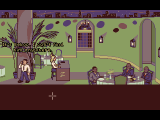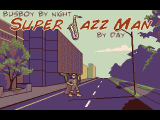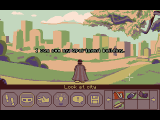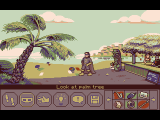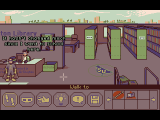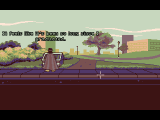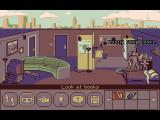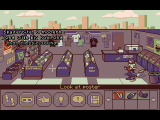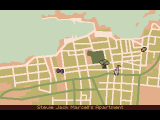Nostalgia is to memory as kitsch is to art –Charles Maier
Stevie Jack, I’m sorry to say, but we just didn’t get you. Or more importantly, we didn’t expect you, at least not to come waltzing down the street, dropping Barthes and Foucault, least of all, amidst all that jazz. We received you expectant of two things only: A sequel to The Apprentice, and colourful, fantastical artwork and animation.
Strictly speaking, we got neither.
Only now, three years later, am I prepared to face the fact that I was not ready, Stevie Jack. After all, in ‘06, the commercial AGS scene was still very much in its infancy, with very little on the market beyond The Adventures of Fatman. We had yet to accustom ourselves to the idea of rewarding indie game designers for their time, with the scene additionally still steadfastly shackled to the gaming heritage of the early 90s. All this despite the flavours and flairs of contemporary retro adventuring having already largely reached the plateau of its predecessors: The freeware version of The Shivah, for instance, had been released in June of the same year, and free games like Reactor 09 continued to push the content envelope.
In this article, my primary wish is to illustrate how Herculean Effort’s adventure game, Super Jazz Man, could and would not have been made possible in the heyday of the adventure gaming boom at the turn of the 90s, in the form of a reappraisal of elements and features of the game that we might have, should have paid more attention to at the time. In a fantastic turn of events, having picked the game up for review some weeks back, the game is just now being sold by Dave Gilbert’s Wadjet Eye Games store as the latest part to its “recommended games” series. Timing, it seems, is on Stevie Jack’s side this time around!
Formally, Super Jazz Man masquerades as an adventure game of the superhero variant. At first glance, it contains the immediately familiar symbols and icons of the adventure, ostensibly also matching its look and feel to its subject matter. Starting with the various icons representing various actions (Walk, Look At, Take, Use and Talk, respectively), for instance, the game’s visuals are characterized by that of a caped crusader – commendable attention to detail, indeed – heck, there even exists a special letter “J” reserved for Stevie’s alter-ego; its curvature is that of a saxophone!
The game begins as the aforementioned Mr. S. J. Marcell, a waiter’s helper and an increasingly popular saxophonist, suddenly receives a distress signal from his girlfriend, Cadence, who explains their adorable little kitty, Bebop, has gone awol. Off we go, pointing and clicking the initially-denominated hero in search for a cat. Due to (or despite of?) some light surrealist leanings, it quickly becomes evident that the writing of the game is very competent, with an admirable degree of zing and twang in the dialogue department. At the beginning, for example, Marcell asks the High Rollers, a group of prosperous gangsta rappers at their table,
Marcell: “How is everything tonight?”
The High Rollers: “Real tight”
Real tight indeed: The concise writing never does bore you out over the course of the short to medium -length game, exhibiting the kind of youthful pop culture leanings also found in Dave Gilbert’s Blackwell series; as with Gilbert’s referential style, though, players not overtly familiar with US pop culture and/or the genre of jazz music may have to resort to ogling for references if bothered, but most of the turns of phrases are relatively self-explanatory, with mention of Charlie Parker, Artie Shaw, etcetera.
That being said, beyond the realm of music in the game, the coupling of form and content is not nearly so straight-forwarded as it appears to be at first. Mr. Marcell does indeed have all the makings of a superhero: A costume, a special ability. A secret identity, an alter-ego, a name out of a DeLillo book. A strong-willed girlfriend – a damsel(!) in distress. Villains. The utilization of these elements, however, is rather post-modern, as we do find the more general rules of superhero fiction often being broken down: Marcell, as Super Jazz Man, comfortably blends in the crowd – no questions ever asked about his flamboyant costume or ever-so-protruding instrument.
In several instances, too, the protagonist enters the landscape by floating down from the sky, breaking the laws of physics and entering the hyperreal, yet in others, he is insistent on walking. Some puzzles even take advantage of this seeming disparity, and on one screen, Stevie’s fly-by is classified as a “neat trick” by Cadence’s friends, ultimately leaving us scratching our heads: Is he a superhero, or is he not? What the heck is he, exactly? Also, many of the game’s puzzles utilize tools, items and gadgets rather than the hero’s superpowers, purposely blurring the line. Puzzle-wise, the focus is on real-world problems, though some of these also require thinking outside the box, a few slightly tarnished by obliqueness: Getting stumped is a very real possibility. The best and worst puzzle, I should say, involves lifting weights. Perhaps you’ll agree.
Our eyes are set, for good reason, on the unconventional protagonist, with reviewers eliciting pleasure over having such an atypical lead. 1)http://www.adventuregamers.com/article/id,719/ But what is it, exactly, that makes Super Jazz Man so special, especially if he’s not a superhero per se? Should we see here nothing but a saxophonist in spandex? And how does he compare to the previous decade, of canine craziness, janitorial jeopardy and burly bikers? In that respect, the game’s biggest strength is neither its theme nor characterization, but the breaking and bending of the aforementioned. The games hinted at above – Sam & Max, Space Quest and Full Throttle – all firmly stood within the set limits of their genres, but how about Super Jazz Man?
Certainly, the superhero genre’s deeply wound relationship with detective fiction does create certain compulsory connections: After all, superheroes often function as supernatural detectives, uncovering leads, discovering trails, investigating, interrogating. This is essentially what Super Jazz Man consists of, too. But so do most (if not all) adventure games, by design. Structure and gameplay aside, it seems, neither of the these fictions would adequately explain the deeper make-up of the game; in my view, the key element to unlocking its meaning is the concept of pretending.
Players find themselves positioned, out of the blue, in a game whose structure and setting oddly resembles that of a theatrical performance. In the opening sequence, Super Jazz Man masquerades, if you will, as Stevie Jack Marcell – not the other way round. Also: Indoor locations always have their ceilings omitted, revealing the stylized skyline of the cityscape instead. The absence of roofing leaves you, the player, and the characters peculiarly uncontained, serving as a constant reminder of the game’s fictions and fictional states, also further serving to detach the actors from their dwellings and thus rendering the backgrounds as replaceable set pieces.
Further fuelling this feeling of displacement is the perspective of the camera, which is directly, frontally and conservatively positioned as if players were watching a play from an auditorium. This perspectival choice moves the player more into the role of a member of the audience rather than in the boots of the protagonist.
These factors, in conjunction to the understated art, lead us toward the concept of post-modern pastiche: Bobbing and weaving in-between literary modes, taking portions that fit, parts that don’t, with little worry of established rules or influences, which serve as a starting point for use and abuse thereupon. Even the very name of the game seeks, on the one hand, to position itself – via pastiche – next to the already established discourse, and on the other hand, to separate itself from it. At the danger of sounding haughty, here is a quote from Harold Bloom:
Freedom, in a poem, must mean freedom of meaning, the freedom to have a meaning of one’s own. Such freedom is wholly illusory unless it is achieved against a prior plenitude of meaning, which is tradition, and so also against language. 2)Bloom, Harold. “The Breaking of Form”. Deconstruction and Criticism. 2004. p3
I do not seek to entirely disconnect the game from its sphere; its sincerity and seriousness would prevent me from doing so anyhow. The above quote hopefully nevertheless illustrates both the complexity and the simplicity of a cultural product in relation to its influences. In this way, it seems only natural for us to designate and classify; Even this article is a blatant act of demarcation as I seek to nail down Super Jazz Man, to explain it and nullify it, make it palatable. But playing it today, the game feels resilient, refusing to belong. Yes, we do have our established discourses, of adventure games, of superheroes, of detectives, but can they really be used to define the game?
In my view, Super Jazz Man is not a nostalgic return to any kind of tradition, be it adventure, superhero, detective, sitcom or otherwise. It is a continuation; therefore, the prospect of analysing the production values of the game via concepts such as “old school” or “retro” seems awfully disheartening. Beyond the obvious parallels, like its resolution of 320×200 and the omission of voice acting, we have not seen such strict palette work since the very dawn of gaming, and even then, Super Jazz Man’s selection of colour and shape is 100 percent methodological decision-making.
I do admit to having filed the game under generic terminology back at the time of its release. I thought I agreed when the now defunct Man!festoGames described the game as “a nostalgic homage to 1980s LucasArts adventures”; I paid little attention when AdventureGamers saw the game as “the fun nostalgia-fest it aims to be” 3)http://www.adventuregamers.com/article/id,719/. But today, when the Wadjet Eye games website files the game under “nostalgic low-color graphics” 4)http://www.wadjeteyegames.com/recommended.html?1252422589, I accept the market-driven need to designate, but refuse the rest.
For in this case, the carefully selected monochrome-toned palette, the geometric abstractions and colour fields, and the comical, pop-arty pixeled characters are all conscious methodological choices on the part of the developers. There is a world of difference between a self-imposed limit and a dictated limit, after all. While the understated technical aspects were also undeniably motivated by constraints with resources, manpower and time, comparing such application of technique to, say, the hardware-imposed limitations of the “Quest” series, strikes me as simply uneducated.
After all, there are wide-ranging possibilities for pixel artists to engage in meaningful methodological, technical and stylistic conversation about palettes, animation, shapes and technique on websites like Pixeljoint or Pixelation. The Schlaepfer brothers are known to take part in this discourse, and I can assure you, very little about the game’s look and feel is unmediated. The game may not have the same kind of vibrancy and vivacity the brothers’ other series, The Apprentice does, but even as is, the beach scene of the game is one my favourite pixel art pieces to date.
Yes, the understated graphical style is a bold choice, worthy of note, and perhaps best illustrated by my favourite piece from the game – its “world” map:
Laugh if you want, but also see the strong-willed elegance of the lines, the interplay of the unisonous, mild-mannered tones, the geometric, surficial balance. But aren’t we forgetting something? A jazz-themed venture, surely, must have its music dissected. The soundtrack, then, composed by Greg Schlaepfer, first feels strangely informed by the easygoing lounge ditties of Sierra’s Leisure Suit Larry series. A backwardly and fallacious interpretation as any: After all, all there is to this connection is the haphazard nostalgia hampering my interpretation and the indefinite, uncertain potentiality that these two games share some aural influence from the past…
Though midi-based, the music thoroughly exhibits a smooth, jazzy style and register, sometimes bordering on lounge, even swing on others; this is perhaps why, at times, the music felt just an iota too insistent, too spirited and piquant, but is obviously well-read, thought-out and more than a fitting match overall. Additional saxophonic solo interludes – courtesy of Brendan Buss – are thrown in for good measure.
Even by today’s standards for indie games, Super Jazz Man is polished, and adventure gaming specialists will know to appreciate a vast array of hotspot actions and reactions, something often missing from non-commercial (and even the commercial ones!) projects. Minor sour grapes – from a perfectionist point of view – might include the lack of rotating the various available actions with the right mouse button, a handful of puzzles out there and perhaps a slightly wonky action sequence at the very end that also bring the otherwise classy gameplay down just a notch.
My first-hand experience of the game, during the Christmas holidays of the year 2006, was very much characterized by feelings of disappointment, as the game failed to answer to my expectations in any tangible way. Today, no longer bound by the baggage of its position in the genre, and free of its sequential expectations, the game feels vastly improved. This time around, I enjoyed playing the game, and I do believe you would too: After all, the brothers Schlaepfer are a proven commodity, always able to provide a game equipped with a solid interplay of visuals, content and sound.
What seemed like a misstep at the time, coming off the heels of the first two Apprentices, now feels like a logical, if unexpected, continuation of Herculean Effort’s experimentation with style, content and form.
Super Jazz Man was originally released in December 2006 and is still available on the Herculean Effort website. A playable demo can be downloaded and the game no longer comes packaged with copyprotection. Lastly, the game is available at Wadjet Eye Games’ recommended games section, for the price of $9.99.
References
| 1, 3. | ↑ | http://www.adventuregamers.com/article/id,719/ |
| 2. | ↑ | Bloom, Harold. “The Breaking of Form”. Deconstruction and Criticism. 2004. p3 |
| 4. | ↑ | http://www.wadjeteyegames.com/recommended.html?1252422589 |
